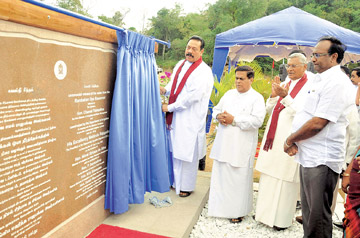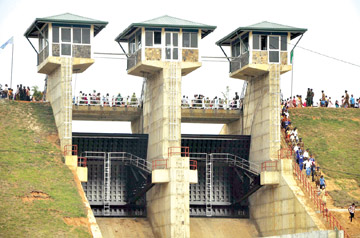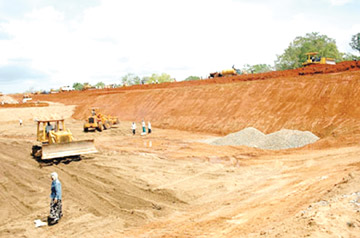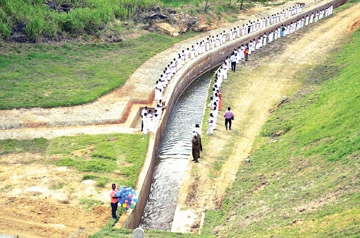|
Rambakenoya project:
More land under the plough for Maha and Yala season
By Naalir Jamaldeen
 |
| President
Mahinda Rajapaksa unveils the plaque of Rambakenoya reservoir |
 |
| Newly
constructed spill gates. |
 |
| The spill gate
construction site |
 |
| Work in
progress |
 |
| School
children at the water releasing session to the canal. |
The Rambakenoya reservoir will be a boon and will improve the economy
and livelihood in the region. Over 4,000 acres of cultivable land will
come under the plough in the Maha and Yala Seasons. Rambakenoya is one
of the main irrigation projects after the Galoya project in the
Digamadulla district, a spokesman for the Irrigation and Water Resources
Management Ministry said.
Sri Lanka's irrigation system has a long history which began since
the era of local kings who ruled the country. Irrigation and agriculture
is interconnected with the life of people since ancient days. The
history of agriculture began with the advent of the Aryans. King Maha
Prakramabahu once had said that even a single drop of water should not
be left to waste and sent into the sea. His eagerness to improve the
agriculture sector was immeasurable.
Mahinda Chinthanaya national development concept was formulated to
find an immediate solution to the problems of the rural people,
President Mahinda Rajapaksa said after commissioning the Rambakenoya
reservoir.
A large number of small, medium and large scale irrigation
development projects have been implemented across the country including
Deduru Oya in the Kurunegala district, Moragahakanda and Rambakenoya in
the Matale and Ampara districts. The Deduru Oya project is expected to
be completed by the end of this year and the development work of
Moragahakanda reservoir has been expedited, President Rajapaksa said.
"After achieving the historical victory against terrorism, we
promised the people that the country will have enough water to achieve
self-sufficiency in agriculture and to help people victimised by
terrorism" the President said.
The development work of the Weharagala reservoir has already been
completed. Kekilogoda Mawara in Hambantota, Ellapothana in Anuradhapura,
Kalugaloya in Ampara, Uma Oya in Wellawaya, Kumbukkan Oya in Monaragala
and Yan Oya in Trincomalee are some of the other irrigation projects
implemented by the Government, he said.
The Government has planned to implement more irrigation projects
soon. Villages are the main stakeholders of all these development
projects, the President said.
The Rambakenoya reservoir development project was completed at a cost
of Rs. 3,970 million funded by the Government.
 |
|
A section of the people who
were present at the commissioning ceremony. |
History records says that Rambakenoya was constructed by King
Sadhhathissa in 400 AD. However, the work was never completed.
The Rambakenoya reservoir has been constructed by building a bund
3,600 feet in length and 81 feet in height across the Rambakenoya river.
The project will provide permanent solution to the water problems in
agriculture a and drinking water as well. The Rambakenoya area will also
be developed as the 10th Mahaweli zone. The people in the Eastern
province will benefit with the implementation of the reservoir
development project, Irrigation and Water Resources Development Ministry
sources said.
Earlier agricultural activities in the Rambakenoya, Maha Oya,
Padiyathalawa and Ridmaliyadda depended on rain water. Crop destruction
accompanied by the drought due to lack of rainfall
in these areas where farmers experienced losses. There was permanent
water source to facilitate cultivation. Most of the farmers were engaged
in chena cultivation, according to Ministry sources.
The Government has taken steps to develop infrastructure facilities
in Maha Oya, Padiyathalawa and Ridmaliyadda and other Divisional
Secretariat Divisions in the Digamadulla district in line with the
Rambakenoya reservoir development project, Ministry sources said.
The monthly income of over 23,000 families who live in the Maha Oya
Divisional Secretariat (DS) Division is low compared their income and
undergo to inconvenience. Education activities of their children have
also been affected by poverty.
Then Irrigation Minister, Chamal Rajapaksa laid the foundation stone
for the the Rambakenoya Reservoir development project in February 12,
2007.
Plans are afoot to provide water to 12,000 acres of cultivable land
in the Mitiyawatta area on par with the Rambakenoya reservoir
development project, Ministry sources said.
The Government has implemented various livelihood, community and
infrastructure development projects in the region.
Meanwhile steps have been taken to provide accommodation facilities
to Mahaveli officers and to construct houses for teachers and health
sector officers in the Pollebedda area, the sources said. Several
infrastructure development programs will also be implemented in the
Ridimaliyadda division. Kiriwelladda tank will be developed while
renovating the Yodhawewa Anicut, Ministry sources said.
The Government has implemented diverse development projects in
Pollebedda area parallel to Rambakenoya reservoir development project
such as providing water to 1,700 acres of paddy land, the Ministry
sources pointed out.
Livestock development is one among the livelihood development
projects to be implemented in the Rambakenoya area. A Rs. 50,000 worth
dairy cow will be given to farmers willing to run dairy farms. Chicks
will also be provided to farmers free of charge.
Enough incentives and technical assistance will be provided by the
Government to promote highland crop cultivation and home gardening under
the Rambakenoya scheme. The same program will be implemented in the Maha
Oya, Padiyathalawa and Ridimaliyadda areas, Ministry sources said.
Steps have been taken to introduce mango, guava, pomegranate, paper
and papaya cultivation in these areas. In the initial stage it will be
carried out as a pilot project and depending on the success will be
expanded to other areas in the region, sources said.
A cashew preservation centre will be set up at Ridimaliyadda.
A series of training sessions will be conducted for the farmers in
the area to teach them about modern agricultural technology and how to
handle modern agricultural equipment. They will also be given a chance
to handle and see modern agricultural equipment. A nursery has been set
up at Hingurulanda to supply various varieties of coconut plants to
farmers, sources said. |


